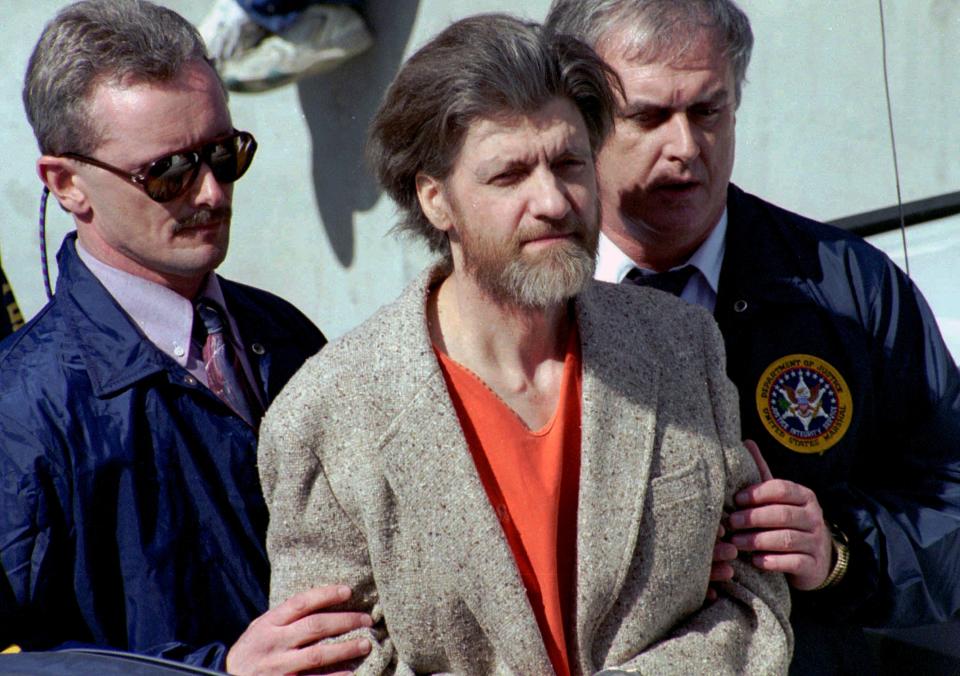'Unabomber' Theodore Kaczynski's ties to University of Michigan continued into prison term
- Oops!Something went wrong.Please try again later.
Theodore “Ted” Kaczynski, better known as the "Unabomber," was found dead Saturday at a prison medical facility in North Carolina. He was 81.
From 1978 to 1995, Kaczynski was responsible for 16 explosive devices, including several sent to university officials and one that detonated in the luggage compartment of an airplane. The FBI developed a task force to investigate the "UNABOM" (UNiversity and Airline BOMbing) incidents. The code name morphed into "Unabomber" in media reports.
The devices killed three people and injured more than 20, including a University of Michigan graduate assistant and psychology professor.
His ties to the university started more than two decades earlier and continued beyond his arrest in 1996 and sentencing in 1998.

After graduating high school at age 16 and earning a bachelor’s degree in mathematics from Harvard, Kaczynski earned two degrees from the University of Michigan: a master’s in mathematics in 1964 and a doctorate in the same field in 1967.
After completing his doctorate at Michigan, Kaczynski became the youngest assistant professor in the history of the University of California-Berkeley at age 25. After two years, he resigned without giving a reason and returned to his native Illinois, living with his parents in the Chicago area for two years before moving to a cabin in Lincoln, Montana, in 1971. Neighbors say he lived like a hermit in the cabin, with no plumbing or electricity.
It was in that cabin that he made his bombs.
According to an FBI list of the devices Kaczynski sent, the first went to a professor at Northwestern University in 1978. Nine of the 16 devices were sent to universities or the homes of university officials, including one to the home of a U-M professor.
In November 1985, graduate student Nicklaus Suino was working at the home of U-M psychology professor James McConnell in Scio Township when he opened a mail bomb. In a lawsuit, Suino said the bombing left him with burns, bruises, hearing loss, blurred vision and other injuries. McConnell’s hearing was also damaged in the bombing. A 1996 report from the Free Press says that while McConnell and Kaczynski were both on campus in Ann Arbor at the same time in the ‘60s, “there is no indication the two knew each other.” McConnell died in 1990, before Kaczynski was identified as the Unabomber.
Who was the 'Unabomber'? A look back at Ted Kaczynski, who killed three and died in prison
More: Former federal judge Robert Holmes Bell dies at 79
In 1995, Kaczynski sent a 35,000-word manifesto to the New York Times and Washington Post. Both published the manifesto, at the recommendation of the Attorney General Janet Reno and FBI Director Louis Freeh, who hoped someone who read the document would be able to identify the author. The manifesto led to thousands of suggestions for suspects, including one from David Kaczynski, Ted's brother. David provided letters and documents written by Ted. Linguistic analysis determined the manifesto was from the same writer, and the FBI arrested Kaczynski in his cabin in April 1996.
Kaczynski's writings continued his ties to the University of Michigan, even after he was sent to prison.
In 1999, U-M’s Harlan Hatcher Graduate Library announced it had reached an exclusive agreement to receive Kaczynski’s prison correspondence. “A 5-foot stack of hundreds of letters written by people around the world to Kaczynski and his responses to some of the letters” were delivered to the library in fall 1999 after two years of negotiations, a university spokesperson said. Kaczynski agreed to provide the letters at no charge.
Kaczynski also tried to donate the writings left in his Montana cabin to the university, but a 2004 federal court ruling said Kaczynski had “no right to donate his writings” and that the government legally possesses the papers on behalf of Kaczynski’s victims.
This article originally appeared on Detroit Free Press: 'Unabomber' Theodore Kaczynski had deep ties to University of Michigan

